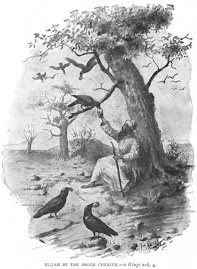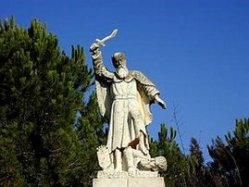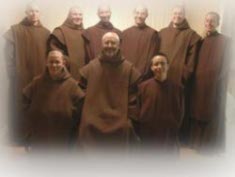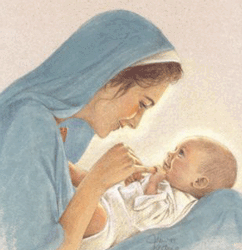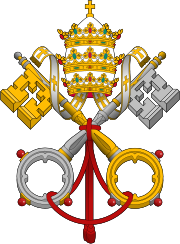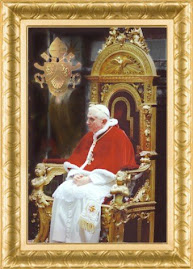Reflections on the Seven Dolours of Mary - preparation for the Feast of Seven Sorrows of Our Lady
 "On the Second Dolour - of the Flight of Jesus into Egypt"
"On the Second Dolour - of the Flight of Jesus into Egypt"As the stag, wounded by an arrow, carries the pain with him wherever he goes, because he carries with him the arrow which has wounded him, so did the Divine Mother, after the sad prophecy of Saint Simeon, as we have already seen in the consideration of the first dolour, always carry her sorrow with her in the continual remembrance of the Passion of her Son. Hailgrino, explaining this passage of the Cantilcles, "The hairs of thy head, as the purple of the king, bound in the channel." (Cant 7:5) says that these purple hairs were Mary's continual thoughts of the Passion of Jesus, which kept the blood which was one day to flow from His wounds always before her eyes: 'Thy mind, O Mary, and Thy thoughts, steeped in the blood of our Lord's Passion, were always filled from His wounds always before her eyes...Let us consider the second sword of sorrow which wounded Mary, in the flight of her Infant Jesus into Egypt from the persecution of Herod. Herod, having heard the expected Messias was born, foolishly feared that He would deprived him of his kingdom. ...
Any one can imagine what Mary must have suffered on this journey. To Egypt the distance was great. Most authors agree that it was three hundred miles; so that it was a journey of upwards of thirty days. The road was, according to Saint Bonaventure's description of it, 'rough, unknown, and little frequented' (De Vitae Christi, cap 12). It was in the winter season; so that they had to travel in snow, rain, and wind, through rough and dirty roads. Mary was then fifteen years of age - a delicate young woman, unaccustomed to such journeys. They had no one to attend upon them. Saint Peter Chrysologus says, 'Joseph and Mary have no male or female servants; they were themselves both masters and servants.' O God, what a touching sight must it have been to have behold that tender Virgin with her new-born Babe wandering through the world!......They resided in Egypt, according to Brocard and Jansenius, in a district called Maturea; though Saint Anselm says that they lived in the city of Heliopolis, or at Memphis, now called old Cairo. Here let us consider the great poverty they must have suffered during the seven years which, according to Saint Antoninus, Saint Thomas, and others, they spent there. They were foreigners unknown, without revenues, money, or relations, barely able to support themselves by their humble efforts. 'As they were destitute', says Saint Basil, 'it is evident that they must have laboured much to provide themselves with the necessities of life.' ....After the death of Herod, Saint Matthew relates, the angel appeared again to Saint Joseph in a dream, and directed him to return to Judea. Saint Bonaventura, speaking of this return, considers how much greater the Blessed Virgin's sufferings must have been on account of the pains of Jesus being so much increased, as He was then about seven years of age - an age, remarks the Saint, at which 'He was too big to be carried, and not strong enough to walk without assistance'.
The sight then, of Jesus and Mary wandering as fugitives through the world teaches us that we also must live as pilgrims here below, detached from the goods which the world offers us, and which we must soon leave to enter eternity: "We have not here a lasting city, but seek one that is to come." (Heb 13: 14). To which Saint Augustine adds: 'Thou art a guest; thou givest a look, and passest on.' It also teaches us to embrace crossess, for without them we cannot live in this world. Blessed Veronica da Binasco, an Augustinian nun, was carried in spirit to accompany Mary with the Infant Jesus on their journey into Egypt; and after it the Divine Mother said, 'Daughter, thou hast seen with how much difficulty we have reached this country; now learn that no one receives graces without suffering.' Whoever wishes to feel less the sufferings of this life must go in company with Jesus and Mary; "Take the Child and His Mother" (Matt 2: 13). All sufferings become light, and even sweet and desirable, to him who by his love bears this Son and this Mother in his heart. Let us, then, love them; let us console Mary by welcoming in our hearts her Son, whom men even now continue to persecute by their sins.
PRAYER
O sorrowful Mother...by the sufferings thou didst endure in thy journey to Egypt, assist me in the journey in which I am now engaged towards eternity; that thus I may at length be united with thee in loving my persecuted Saviour in the kingdom of the blessed. Amen.
Text after "The Glories of Mary" by St. Alphonsus Liguori
Picture is by Albrecht Duerer "Seven Dolours of the Blessed Virgin Mary"
Any one can imagine what Mary must have suffered on this journey. To Egypt the distance was great. Most authors agree that it was three hundred miles; so that it was a journey of upwards of thirty days. The road was, according to Saint Bonaventure's description of it, 'rough, unknown, and little frequented' (De Vitae Christi, cap 12). It was in the winter season; so that they had to travel in snow, rain, and wind, through rough and dirty roads. Mary was then fifteen years of age - a delicate young woman, unaccustomed to such journeys. They had no one to attend upon them. Saint Peter Chrysologus says, 'Joseph and Mary have no male or female servants; they were themselves both masters and servants.' O God, what a touching sight must it have been to have behold that tender Virgin with her new-born Babe wandering through the world!......They resided in Egypt, according to Brocard and Jansenius, in a district called Maturea; though Saint Anselm says that they lived in the city of Heliopolis, or at Memphis, now called old Cairo. Here let us consider the great poverty they must have suffered during the seven years which, according to Saint Antoninus, Saint Thomas, and others, they spent there. They were foreigners unknown, without revenues, money, or relations, barely able to support themselves by their humble efforts. 'As they were destitute', says Saint Basil, 'it is evident that they must have laboured much to provide themselves with the necessities of life.' ....After the death of Herod, Saint Matthew relates, the angel appeared again to Saint Joseph in a dream, and directed him to return to Judea. Saint Bonaventura, speaking of this return, considers how much greater the Blessed Virgin's sufferings must have been on account of the pains of Jesus being so much increased, as He was then about seven years of age - an age, remarks the Saint, at which 'He was too big to be carried, and not strong enough to walk without assistance'.
The sight then, of Jesus and Mary wandering as fugitives through the world teaches us that we also must live as pilgrims here below, detached from the goods which the world offers us, and which we must soon leave to enter eternity: "We have not here a lasting city, but seek one that is to come." (Heb 13: 14). To which Saint Augustine adds: 'Thou art a guest; thou givest a look, and passest on.' It also teaches us to embrace crossess, for without them we cannot live in this world. Blessed Veronica da Binasco, an Augustinian nun, was carried in spirit to accompany Mary with the Infant Jesus on their journey into Egypt; and after it the Divine Mother said, 'Daughter, thou hast seen with how much difficulty we have reached this country; now learn that no one receives graces without suffering.' Whoever wishes to feel less the sufferings of this life must go in company with Jesus and Mary; "Take the Child and His Mother" (Matt 2: 13). All sufferings become light, and even sweet and desirable, to him who by his love bears this Son and this Mother in his heart. Let us, then, love them; let us console Mary by welcoming in our hearts her Son, whom men even now continue to persecute by their sins.
PRAYER
O sorrowful Mother...by the sufferings thou didst endure in thy journey to Egypt, assist me in the journey in which I am now engaged towards eternity; that thus I may at length be united with thee in loving my persecuted Saviour in the kingdom of the blessed. Amen.
Text after "The Glories of Mary" by St. Alphonsus Liguori
Picture is by Albrecht Duerer "Seven Dolours of the Blessed Virgin Mary"




